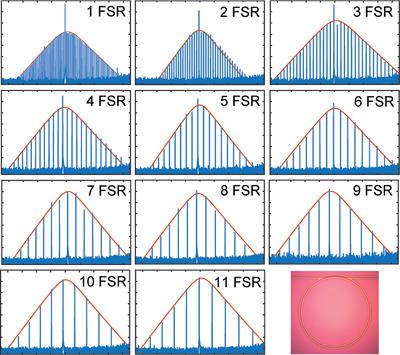当前位置:
X-MOL 学术
›
Laser Photonics Rev.
›
论文详情
Our official English website, www.x-mol.net, welcomes your
feedback! (Note: you will need to create a separate account there.)
Perfect Soliton Crystals on Demand
Laser & Photonics Reviews ( IF 9.8 ) Pub Date : 2020-07-08 , DOI: 10.1002/lpor.201900339 Yang He 1 , Jingwei Ling 1 , Mingxiao Li 1 , Qiang Lin 1
Laser & Photonics Reviews ( IF 9.8 ) Pub Date : 2020-07-08 , DOI: 10.1002/lpor.201900339 Yang He 1 , Jingwei Ling 1 , Mingxiao Li 1 , Qiang Lin 1
Affiliation

|
Recent advances in of soliton microcombs have shown great promise to revolutionize many important areas such as optical communication, spectroscopic sensing, optical clock, and frequency synthesis. A largely tunable comb line spacing is crucial for the practical application of soliton microcombs, which unfortunately is challenging to realize for an on‐chip monolithic microresonators. The recently discovered perfect soliton crystal (PSC) offers a convenient route to tune the comb line spacing. However, excitation of a PSC is generally stochastic by its nature and accessing a certain PSC state requires delicate tuning procedure. Here the on‐demand generation of PSCs in a lithium niobate microresonator is demonstrated. The unique device characteristics allow to produce a variety of PSCs and to switch between different PSC states, deterministically and repetitively. The device is utilized to show arbitrary dialing of the comb line spacing from 1 to 11 times of the free‐spectral range of the resonator. The demonstration of PSCs on demand may now open up a great avenue for flexibly controlling the repetition rate of soliton pulses, which would significantly enhance and extend the application potential of soliton microcombs for communication, signal processing, and sensing.
中文翻译:

按需完美孤晶
孤子微梳的最新进展显示出巨大的希望,有望彻底改变许多重要领域,例如光通信,光谱传感,光时钟和频率合成。对于孤子微梳子的实际应用来说,可调节的梳线间距是至关重要的,不幸的是,对于片上单片微谐振器而言,实现这一点非常困难。最近发现的完美孤子晶体(PSC)提供了一条方便的途径来调整梳齿线间距。但是,PSC的激励通常是随机的,进入某个PSC状态需要精细的调整过程。这里展示了铌酸锂微谐振器中按需生成的PSC。独特的设备特性允许产生多种PSC,并可以在不同的PSC状态之间进行切换,确定性地和重复地。该设备用于显示梳齿线间距的任意刻度,范围是谐振器自由光谱范围的1到11倍。现在,按需演示PSC可能会为灵活控制孤子脉冲的重复率开辟一条很好的途径,这将显着增强和扩展孤子微梳在通信,信号处理和传感方面的应用潜力。
更新日期:2020-07-08
中文翻译:

按需完美孤晶
孤子微梳的最新进展显示出巨大的希望,有望彻底改变许多重要领域,例如光通信,光谱传感,光时钟和频率合成。对于孤子微梳子的实际应用来说,可调节的梳线间距是至关重要的,不幸的是,对于片上单片微谐振器而言,实现这一点非常困难。最近发现的完美孤子晶体(PSC)提供了一条方便的途径来调整梳齿线间距。但是,PSC的激励通常是随机的,进入某个PSC状态需要精细的调整过程。这里展示了铌酸锂微谐振器中按需生成的PSC。独特的设备特性允许产生多种PSC,并可以在不同的PSC状态之间进行切换,确定性地和重复地。该设备用于显示梳齿线间距的任意刻度,范围是谐振器自由光谱范围的1到11倍。现在,按需演示PSC可能会为灵活控制孤子脉冲的重复率开辟一条很好的途径,这将显着增强和扩展孤子微梳在通信,信号处理和传感方面的应用潜力。











































 京公网安备 11010802027423号
京公网安备 11010802027423号